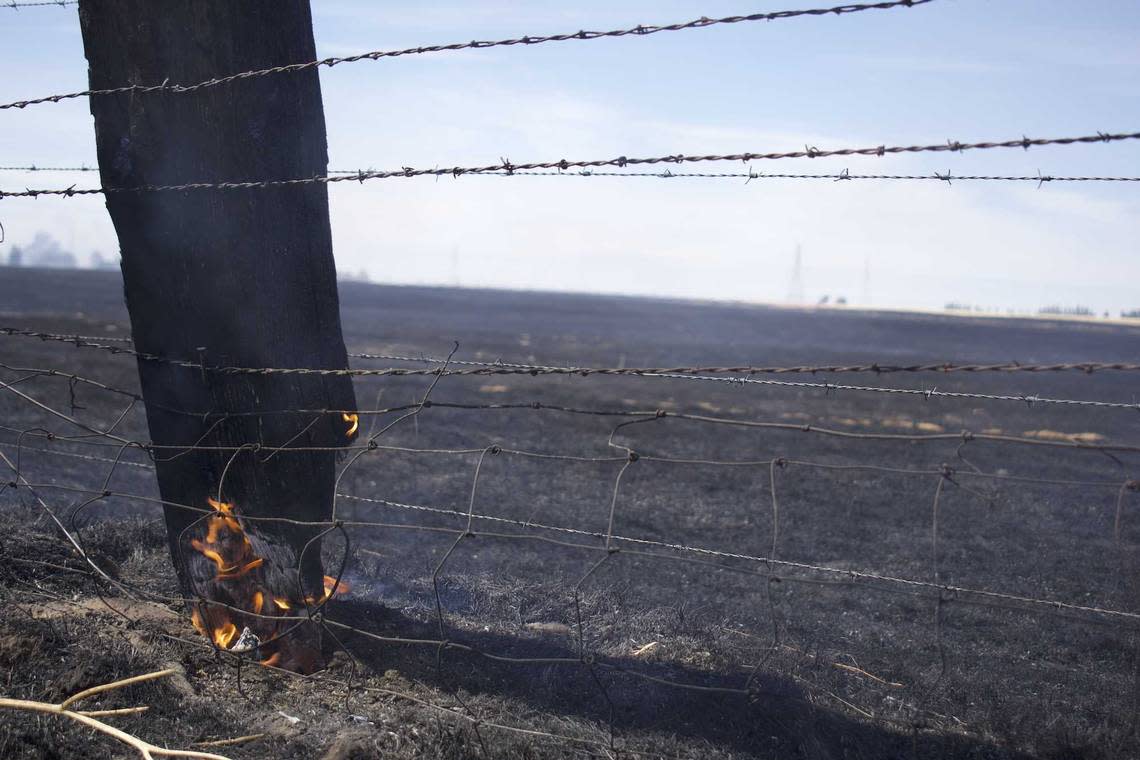California grass fires may indicate severe wildfire season this summer, experts warn

A fire in southeastern Sacramento County is among a handful of recent fast-burning grass fires that signal the beginning of what experts warn could be a serious fire season in California and across the West, especially at low elevations.
“We’re starting to see increased activity, but nothing all that out of the ordinary yet. I think that’s going to start to change within the next couple weeks,” said Daniel Swain, a climate scientist with UCLA.
By July, he expects the state to find itself in “a really active fire season.”
Hot temperatures in spring and early summer dried out the grasses and brush brought on by two years of heavy rain and snow, Swain said. That means dry, low-elevation grasses are ripe to burn with the addition of hot temperatures and wind.
Higher elevation areas including the mountainous Sierra Nevada region are still benefiting from the melting snowpack but that could change later this summer and autumn, especially with predictions of above-average temperatures.
The Excelsior fire burned approximately 900 acres, and firefighters said they fully contained it by Monday morning. The blaze was small compared to the largest blaze so far this year, dubbed the Post fire in Southern California.
It moved quickly, burning more than 15,000 acres in a single day fueled by hot, windy conditions. It has forced the evacuation of about 1,200 people and remains active.
The National Weather Service Sacramento issued a red flag warning across the Central Valley through Tuesday, citing gusty winds and dry conditions.
A Red Flag Warning continues through 8 am Tuesday across the Valley and adjacent foothills below 2000'.
Gusty north winds + dry conditions will result in easier fire starts & potential for rapid fire spread.
Practice fire weather safety and remain weather aware! #CAwx pic.twitter.com/JDk2wFgrem— NWS Sacramento (@NWSSacramento) June 17, 2024
Part of the increasing wildfire threat is the American West’s transition from El Niño to La Niña climate patterns, which tends to prompt drought in the southwest and heavy rains in the Pacific Northwest.
This transition can typically take several months but is now happening much more quickly, said Brian Newman, assistant chief of Cal Fire’s Amador-El Dorado unit. This quick shift coupled with tall, dry grasses and shrubs likely translates to an active late summer.
“We anticipate the continuation of being busy,” Newman said. “We’ve had fires similar to the number of ignitions we’ve been having in the grass, but with the really tall grasses and abundant brush the fires are really active and able to burn hotter and more aggressively.”
With fire season getting underway after a two year respite, he encouraged Californians to work on their defensible space at home. He also cautioned against campfires and avoiding the possibility of any sparks, from lawn mowers to dragging boats and trailers with chains.
After years of devastating drought, the state saw a record-breaking snowfall in 2022 and a healthy rainy season in 2023. All that rain and snow led to a period of wildfire respite, but the southern Sierra Nevada is remains vulnerable to burning with so many dead trees.
“When you get big wet years, it buys you a little bit of a buffer, especially in forest systems,” said Malcolm North, associate professor of forest ecology at University of California, Davis. “I’m not seeing anything suggesting we have exceptionally dry fuels, with the exception of the southern Sierras.”
Wildfire is a natural part of California’s ecosystem, but scientists point to a century of fire suppression in forests coupled with the effects of human-caused climate change as reasons for the West’s worsening wildfires.
Swain, the UCLA scientist, said this coming wildfire season marks yet another example of climate change-caused weather whiplash — where we’re seeing the effects of a faster cycle between wet and dry conditions.
High temperatures mean both more intense rainfall during wet periods, which grows dense grass and brush, as well as a thirstier atmosphere during dry times that parches vegetation and makes it ripe to burn.
“The worst climate for wildfires is one that gets a lot hotter, as ours is, and alternates between extremely wet and extremely dry conditions,” he said. “There’s a lot of evidence that that’s likely where we’re headed in the West.”

